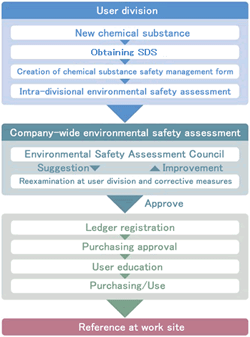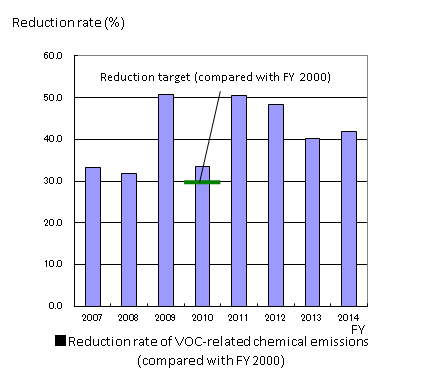Environmental Report 2015
Chemical Substance Management
The introduction of a new chemical substance or piece of equipment, construction work, increased waste volume, and other changes requires an environmental safety assessment under JAE's in-house pre-assessment system as shown in the flowchart below.For chemical substances, it has prepared an ad hoc chemical substance safety management form for the entry of requisite information on items including transport, storage, handling, and disposal. New chemical substances in particular can only be purchased if they pass this assessment. The pre-assessment flow for new chemical substances is shown below. The number of chemical substances registered in 2014 was on par with that of the previous year. However, as it has been increasing in recent years, the company will actively implement cuts in chemical substances that are no longer needed.


substances
Reduction of Chemical Substances
As in the previous fiscal year, in fiscal 2014 each production site selected specific chemicals and worked to reduce the amount used in order to reduce its environmental impact. The main points of the activities for reducing the use of chemicals in fiscal 2014 are shown below, and these reduction efforts will continue in the coming years.Note that the letters in parentheses, such as JAE, HAE, YAE, FAE and SAE, are abbreviations denoting sites that carried out these activities.
- Reduction of the metal used for deposition in gold plating (JAE)
- Reducing chemical usage by revising the plating production process (HAE)
- Reduction of the amount of chemicals used by revising facility introduction and production processes, and by cutting back on the amount purchased (HAE, YAE and SAE)
- Reduction in the amount of VOC-emissions by improving the airtightness of containers and making production processes more efficient (JAE)
PRTR Data
The graph below shows the change in the amount of chemicals subject to the PRTR Law (*use cursor to view definitions) that was used by five domestic manufacturing companies.In fiscal 2014, it became apparent that there was an increased volume of 1-bromopropane, which was the result of higher production volume. Reducing the amount of waste is also key to dealing with substances subject to PRTR, and along with promoting recycling, the JAE Group is working hard to identify trends.

VOC Information
The JAE Group has been reducing VOC-related (*use cursor to view definitions) chemical emissions each year, primarily for isopropyl alcohol. In response to the Japanese government’s 30% reduction target for fiscal 2010, JAE sites had a reduction rate of 34%, meeting the Group’s target. Monitoring has continued since fiscal 2011, and for fiscal 2014, the reduction rate was 41.8%.
■Reduction rate of VOC-related chemical emissions
(compared with FY 2000)
(compared with FY 2000)
The following was accomplished in fiscal 2014.
(1)Improved operational management of poisonous and deleterious chemical substances
With regard to the inventory of poisonous and deleterious chemical substances at JAE sites, the report form was revised and operations improved. JAE will continue to strive to streamline the management of chemical substances.
(2)GHS (*use the cursor to view definition) symbol education
JAE conducted e-learning (*use the cursor to view definition) concerning GHS symbols for operators and managers of chemical substances. This education took place at each site of JAE, HAE, YAE, FAE and SAE. JAE continues its efforts to provide information on dangerously toxic substances.